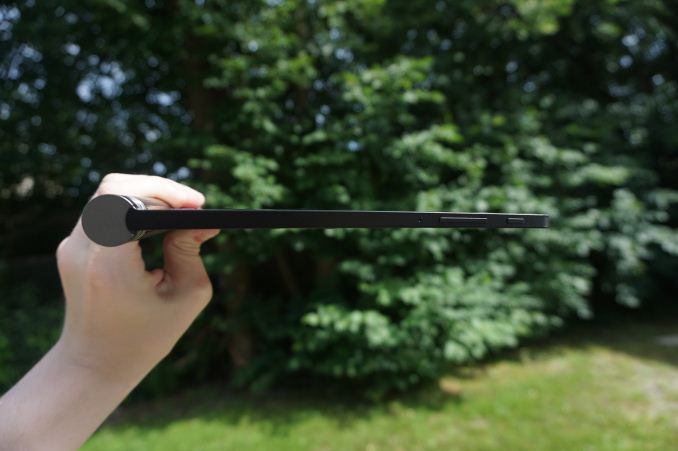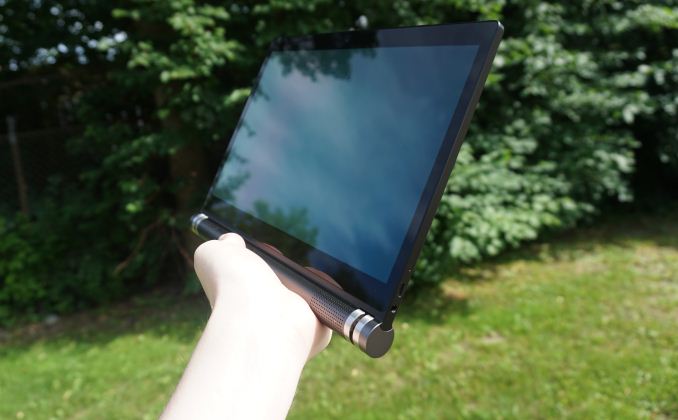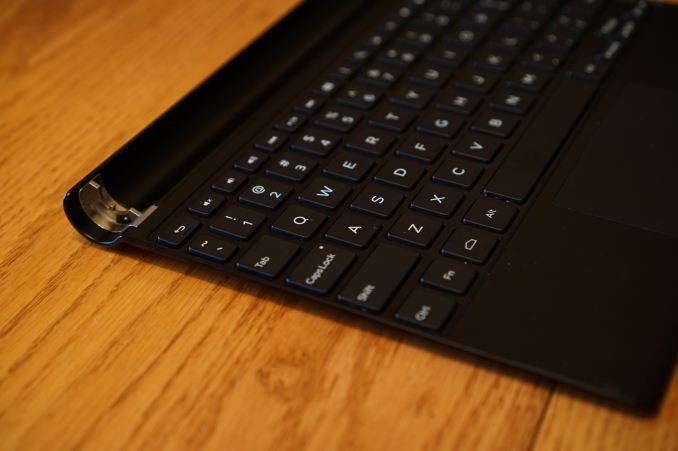The Dell Venue 10 7040 Review
by Brandon Chester on June 30, 2015 8:00 AM ESTFinal Words
When I reviewed the Venue 8, my main point of comparison was the Google Nexus 9. While the iPad Air and iPad Mini 3 should also be considered, for someone who really wants an Android device the Nexus 9 was the clear alternative. I ultimately concluded that the Nexus 9 was a better device for your money, even if the build quality was not near as good as the Venue 8. With the Venue 10 it's difficult to find an equivalently priced Android tablet. The strategy for dealing with the iPad has usually been to compete on price, and at $399 the Nexus 9 is actually one of the more expensive tablets from recent times. Samsung's Galaxy Tab S devices are certainly expensive, but they're over a year old by this point and due for a replacement.
Since the Venue 10 has similar hardware to the Venue 8, the Nexus 9 can still be used as a comparison device. In this case the Venue 10 would have to justify a $100 increase in price from the Nexus 9's $399 cost. On the Apple side the most obvious comparison is the iPad Air 2. Finally, the Dell Venue 8 itself is a very relevant comparison due to its similarity but lower price. It's worth going over all the aspects of the Venue 10 and seeing how it compares to the competition before coming to a conclusion about whether or not it's worth purchasing.
As far as build quality goes, the Venue 10 is a very solid device. It feels much more solid than the Nexus 9, with no mushy buttons or chassis flex. But the plastic chassis definitely feels like a downgrade from the Venue 8, and it doesn't feel as nice in the hand as the iPad Air 2. The barrel hinge to connect with the keyboard definitely works well as a hinge, but it has a very negative impact on ergonomics despite Dell's attempts to market it as providing a spine to grip. The tablet is also extremely heavy in general, and much of the mass is concentrated in the barrel hinge which makes the tablet feel unbalanced. The heaviness makes it less pleasant to use for long periods, and I never wanted to take it out of the house with me like I did with the Venue 8 and the iPad Air 2. It really feels like returning to the days of the iPad 2 and iPad 3 where the mass of a tablet confined it to a radius of only a few rooms, with it being put away during travel just like a laptop would be.
The Venue 10's display is a definite improvement over the Venue 8. It's sharper, and the greyscale is much more accurate. However, it can't get as bright at lower APLs, and with the fairly reflective glass there's no way to make it usable outside. At this point I really don't know why tablet vendors haven't started applying anti-reflective coatings like the iPad Air 2 has. With a good AR coating you only need to push the display to around 400 nits to make a tablet perfectly usable outside.
When it comes to color rendition, the Venue 10's display still suffers from calibration issues. The gamut is a lot closer to Adobe RGB than sRGB, but with Android having no level of color management and content being aimed at the sRGB gamut there's obvious oversaturation with all colors. General color mixture accuracy is slightly better than the Venue 8, but still not near as good as the iPad Air 2 or the Nexus 9. If the Venue 10 had the color accuracy of the Galaxy Tab S 10.5" it would probably be my favorite tablet display, but the color accuracy simply isn't at that level.
Performance wise, the Venue 10 is a mixed bag. I think Intel's Silvermont cores are competitive in a $399 tablet like the Venue 8, but at $499 you're going up against the iPad, and A8X is just really fast. We're pretty far into Moorefield's lifespan, and since it's a tablet I have to wonder what might be different if the Venue 10 was using Cherry Trail instead. On the graphics side, the PowerVR G6430 in Intel's Z3580 SoC just isn't up to the task. I think the GPU performance gains in Tegra K1 and A8X were better than one might have predicted, but the end result is that those devices are anywhere between two and three times faster at graphics tasks, and in Tegra K1's case you can find that power in the $299 SHIELD Tablet.
I'm very disappointed in the Venue 10's real world performance. When I reviewed the Venue 8, there were a number of performance issues that I assumed would be fixed with Android Lollipop. The incredibly smooth performance of the ASUS ZenFone 2 served to further confirm this in my mind. Unfortunately, there's clearly something wrong somewhere in the software or hardware stacks, because the Venue 10's performance is erratic and often very poor. The random drops below not just 60fps, but below 30fps are jarring to say the least, and there are a number of animations that always drop frames. With the Nexus 9 being $100 cheaper and exhibiting few or none of these issues, the Dell Venue 10 is really difficult to recommend to anyone who is bothered by janky animations.
While I'm not someone who uses the cameras on a tablet, anyone who intends to should probably consider alternatives. The cameras on Android tablets in general tend to be pretty woeful compared to the iPad Air 2, although I'm hopeful that a new generation tablet with one of Samsung's or Qualcomm's ISPs can change my mind in this regard. The issues with video recording are also really concerning because they demonstrate either a lack of testing to find such a problem, or a lack of action to fix it.
For me, battery life was the area the Venue 10 let me down most. Despite its issues, the Venue 8 had really good battery life even when browsing the web which can cause these AMOLED displays to use a lot of energy. The Venue 10 regresses in every respect, even when tested at 178 nits due to Dell's strange brightness curve. With Dell only advertising 7 hours of usage, it's clear that they were aware of the battery shortfalls. In the high APL web browsing scenario the Venue 10 gets roughly half the battery life of other tablets. This problem carries over to tasks like editing documents or spreadsheets which is what the Venue 10 is supposed to excel at due to its keyboard attachment. The only difference between the Venue 8 and the Venue 10 is the display and a larger battery, and so it's fairly clear where the large increase in power usage is coming from. I don't know why Dell insisted on using this AMOLED panel over an LCD when they were aware of the battery issues it would cause.
If there's one thing that swoops in to save the Venue 10 it's the keyboard dock. It has been a long time since I've seen an Android tablet that was actually designed to integrate well with a keyboard dock. There are Bluetooth wireless keyboards and keyboard docks for the most popular tablets, but they often don't work as well as the one that Dell offers for the Venue 10. ASUS used to be a large proponent of this form factor with their Transformer tablets, but its been some time since we've seen a new model introduced in that line. As far as 2-in-1 Android tablets go, Dell basically has the market to themselves, and their solution works pretty well.
With the Venue 10's keyboard dock, you're actually able to edit documents and spreadsheets on the full area of the display. You can browse the web, type out emails, and respond to messages with a well sized keyboard with a good tactile response. Android also works much better with trackpads than I had expected, although the trackpad on this keyboard dock is small by necessity and not incredibly accurate. Most shocking to me is how I actually felt like I could do more using this Android tablet with a keyboard than I could with the Chromebook Pixel running Chrome OS, which is something that's actually designed to be a laptop.
Unfortunately, the keyboard dock just isn't enough unless it's something you really need. While the Venue 10 is the only 2-in-1 Android tablet I can recommend due to it being one of the only available options, there's honestly no way I can recommend it as a tablet alone, or even to someone who only wants to occasionally use the keyboard. There are just far too many problems, and none of them are acceptable for a $499 device.
To be quite honest, I really question what the extra $100 over the Venue 8 is getting you. Obviously you do get a larger, sharper, and somewhat more accurate display, but you completely sacrifice ergonomics, portability, and trade your aluminum chassis for a mostly plastic one. With almost no apps designed for these large, landscape-focused tablets, I think the Venue 8 actually offers a better experience at $100 less. On top of that, I still believe that the Nexus 9 offers a better experience than the Venue 8, which just makes it another cheaper alternative to the Venue 10. Ultimately, I wish Dell's development cycle had allowed for more time between the release of the Venue 8 and the Venue 10, so that the former's problems could be fixed in the latter. Unfortunately, many of them aren't, and some new problems are introduced to accommodate the keyboard functionality. While Dell may be able to control the 2-in-1 Android tablet market for the time being, I cannot recommend the Venue 10 as a tablet alone.













49 Comments
View All Comments
tsk2k - Tuesday, June 30, 2015 - link
When is the Carrizo review coming out?DigitalFreak - Tuesday, June 30, 2015 - link
I'll save you 8 pages of reading.It sucks.
Hulk - Wednesday, July 1, 2015 - link
Thanks you just saved me 15 minutes. And I'm being totally serious.kyuu - Thursday, July 2, 2015 - link
Can you and the other members of the AMD-hate circle jerk kindly stop infesting the comment section here? Anandtech is a site for people who want to read about tech, not indulge in mindless dickery. Thanks.maglito - Monday, July 6, 2015 - link
Probably when you can actually get a carrizo powered laptop / 2in1. Have you seen any for sale yet? I haven't, and I've been looking. I really want a laptop with 18Gbps HDMI (2.0) and hardware H.265 decode. They were supposed to be available by now....nightbringer57 - Tuesday, June 30, 2015 - link
About the 2 in 1 aspect...I feel the problem of this market niche is the harsh competition from windows 8.1 (soon to be 10) "Tabletbooks" (2 - 1 tablet + netbook devices like the asus T100). Those are really common and you can get very good models around 200-300€. You can really put the keyboard to full use with the (almost) full-fledged Windows compatibility. If you're gonna buy a not-so-good tablet just because it can make an awesome netbook when you need it, those models kick in and ass.
JeremyInNZ - Tuesday, June 30, 2015 - link
The Sony Z4 tablet is arguably the best 10" Android tablet on the market. It also comes with a keyboard doc, and does a much better job then the Dell with it. Just because Dell did a poor job of implementing the idea, does not make it a bad idea.zimanodenea - Tuesday, June 30, 2015 - link
Intel + PowerVR. I'd rather eat dog poop than buy into this combination again.lilmoe - Tuesday, June 30, 2015 - link
What were you expecting? We all know that last generation ATOM's iGPUs suck (and the current x7 sucks a little less). Wait for a $499 Core M tablet if you want something "interesting", and make sure it doesn't go above 1080p if you want 10+ hours of battery life...Samus - Wednesday, July 1, 2015 - link
The elephant in the room here is that this is a $500 Android tablet. $500. Starting price. If it were running Windows this would be a legitimate competitor to the Surface 3.The reality is you can buy two really decent Android tablets for the same price as this, specifically the Asus Transformer. This is basically a $200 Nextbook Ares (includes keyboard) for triple the price. I don't know what Dell is doing here. Covering something in Aluminum doesn't triple its value.